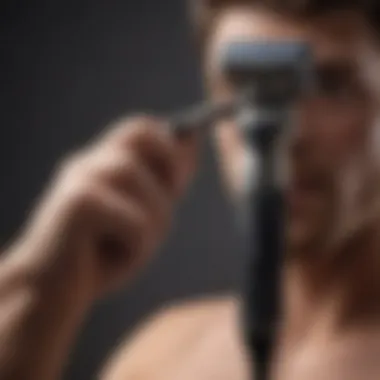Effective Shaving Techniques for the Pubic Area


Intro
Shaving the pubic area is a common practice, yet many experience discomfort and itching afterwards. Understanding effective techniques to make this process smoother is essential. This guide addresses the proper preparation, tools needed, techniques to apply, and aftercare to minimize irritation.
Preparation Steps
Before approaching the shaving process, adequate preparation is key. Start by trimming the hair with scissors or an electric trimmer. This will make the shaving easier and reduce the risk of tugging.
It is advisable to take a warm shower before shaving. Warm water softens the hair and opens the pores. This step enhances the shaving experience. Use gentle soap or body wash to remove any oils or dirt that could interfere with the razor.
Tools Required
Investing in the right tools can significantly improve results. Essential items include:
- Quality Razor: Opt for a razor designed for sensitive skin. A multi-blade razor provides a closer shave but may irritate some skin types.
- Shaving Cream or Gel: Choose a product that is free from harsh chemicals. Look for shaving creams with soothing agents like aloe or chamomile.
- Aftershave or Moisturizer: A good aftershave can calm the skin and reduce irritation. Choose one without alcohol, as that can cause dryness and stinging.
Shaving Techniques
Using proper techniques is vital for a smooth shave. Here are steps to follow:
- Apply Shaving Cream: Generously apply the shaving cream or gel to the area. Allow it to sit for a minute to hydrate the hair.
- Shave with the Grain: Start by shaving in the direction of hair growth. Shaving against the grain can lead to more irritation and ingrown hairs.
- Rinse Often: Rinse the razor frequently to keep the blades unclogged and effective. This helps achieve a closer shave without unnecessary pressure.
- Use Gentle Strokes: Avoid pressing too hard on the razor. Use light, gentle strokes.
- Inspect the Area: After the initial shave, check for any missed patches and carefully go over them if necessary.
Aftercare Practices
Post-shave care is often overlooked, but it is critical in preventing itching and discomfort. After rinsing off the shaving cream, take these steps:
- Cool Water Rinse: This helps close the pores and calm the skin.
- Moisturize: Apply a soothing moisturizer or aftershave balm immediately after. This provides hydration and relief.
- Avoid Tight Clothing: Give your skin room to breathe by wearing loose-fitting underwear. Tight garments can cause friction and irritation.
Skin Care Routine
Integrating a skin care routine is beneficial for long-term comfort. Regular exfoliation can prevent ingrown hairs by removing dead skin cells.
Consider alternatives to shaving if persistent irritation occurs. Options include trimming, waxing, or laser hair removal, each with pros and cons to consider.
"Effective grooming is not just about the techniques; it’s about overall care for your skin."
By adopting a routine that incorporates preparation, proper shaving, and aftercare, irritation can be significantly reduced. With this knowledge, one can approach shaving with ease.
Understanding Pubic Hair Grooming
Pubic hair grooming is a topic that often garners mixed reactions and personal opinions. However, it is crucial to consider the various aspects of managing pubic hair for both aesthetic and hygiene reasons. Understanding how to care for this sensitive area can greatly influence one’s confidence and comfort level in everyday life.
For many, managing pubic hair goes beyond mere appearance. It involves understanding skin sensitivity and its unique grooming needs. Missteps in this area can lead to irritation, discomfort, and unwanted side effects such as itching. Therefore, a systematic and knowledgeable approach to grooming is essential for a positive experience.
Importance of Pubic Hair Management
Managing pubic hair can serve multiple purposes. Primarily, it can enhance personal hygiene. Keeping this area trimmed or shaved can reduce moisture buildup, which is beneficial in preventing infections and unwanted odors. Furthermore, the process of grooming can also improve one's self-image and confidence, particularly in intimate scenarios.
Another significant aspect involves the impact on sexual health. A well-groomed pubic area can foster better communication and shared preferences for those who engage in sexual activity. While some individuals prefer a natural look, others may favor a clean-shaven aesthetic; understanding these preferences is key to maintaining healthy relationships.
Common Concerns Related to Shaving
Shaving the pubic area may lead to several common concerns. The most prevalent issue is irritation, which can manifest as redness, bumps, or an intense itching sensation. These conditions are often a result of improper techniques or inadequate preparation. Many individuals may also contend with razor burn, which is uncomfortable and can lead to anxiety about future grooming sessions.


In addition, there is a concern regarding ingrown hairs, which occur when hair grows back into the skin instead of outward. This can create painful bumps and sometimes lead to infections. To mitigate these risks, educating oneself about proper shaving techniques, as well as aftercare practices, is invaluable.
An understanding of these aspects will only enhance the grooming experience and reduce any negative effects that may arise from shaving. It is critical to approach pubic hair management with knowledge and care, ensuring a balance between aesthetics and health.
Preparing for the Shave
Preparing for the shave is a crucial step in ensuring an effective and comfortable experience. Many people overlook the importance of preparation, thinking that the act of shaving itself is all that matters. However, proper preparation can significantly affect the outcome. It can reduce the risk of irritation, prevent ingrown hairs, and lead to a smoother finish. By taking time to prepare, you can enhance your grooming routine and improve your overall comfort during and after the shave.
Choosing the Right Time
Timing plays a vital role in the shaving process. It is essential to choose a time when your skin is at its best, ideally following a warm shower. Warm water helps in softening the hair, making it easier to shave. This not only provides a closer shave but also minimizes the chance of irritation and dryness afterward. Avoid shaving directly after physical exercise, as sweating can encourage irritation. Instead, find a calm moment when you can focus solely on the grooming task at hand.
Gathering Essential Tools
Having the right tools is fundamental to achieving a comfortable and effective shave. A well-equipped grooming kit can make all the difference. Consider the following essential items:
Razor Types
Razor type is a significant factor when it comes to shaving the pubic area. A multi-blade razor is popular due to its close shave but can cause irritation for some. A single-blade safety razor may be a better option as it can reduce the chance of ingrown hairs. They often allow for more control, reducing the risk of nicks and cuts. Consider your skin type and hair growth patterns when choosing razor type to ensure you find the right fit for your needs.
Shaving Creams and Gels
Shaving creams and gels are critical as they prepare the hair and skin for the shave. An effective product creates a protective barrier, reducing friction and irritation. Look for products that hydrate the skin and are designed for sensitive areas. Gels often provide a clear view of the shaving area, while creams can offer a thicker protective layer. It’s beneficial to choose a product that suits your skin type and needs.
Pre-Shave Oils
Pre-shave oils can further enhance the shaving experience. These oils create an additional layer of protection. They work by softening hair and nourishing the skin underneath. Using such oils can drastically reduce the chances of razor burn and irritation. Look for options with natural ingredients to minimize the risk of allergic reactions or discomfort.
Preparing Your Skin
Proper skin preparation is essential for successful and safe shaving. It sets the stage for a smooth operation and prevents post-shave issues.
Exfoliation Techniques
Exfoliating the skin before shaving helps remove dead skin cells. This process can prevent ingrown hairs and ensure a closer shave. Techniques such as gentle scrubbing with a loofah or using a dedicated exfoliating scrub can be effective. Choose a product that is gentle enough for sensitive skin and use it regularly in your grooming routine.
Hydrating the Skin
Hydration is critical before starting the shave. Ensure that your skin is well-moisturized to maintain its elasticity and softness. Applying a moisturizer or hydrating lotion can help prepare the skin for the razor. This step is often overlooked, but it is essential in ensuring comfort during and after the shave. Properly hydrating the skin can significantly reduce discomfort and prepare it for the shaving process.
Shaving Techniques
Shaving techniques play a crucial role in achieving a smooth and irritation-free grooming experience. Proper techniques not only enhance the effectiveness of shaving but also minimize the risks of post-shave discomfort. Understanding these techniques helps avoid common issues such as redness, ingrown hairs, and excessive itching. Adopting the right approach to shaving can elevate the grooming routine significantly, ensuring both safety and satisfaction.
Prepping the Area
Trimming Long Hair
Trimming long hair is an essential first step before the actual shaving process. This technique reduces the amount of hair that the razor has to cut through, making the overall shave more manageable. The key characteristic of trimming is that it prepares the area by shortening the hair to a length that is easier to shave. Additionally, it helps prevent tugging or pulling of the hair during shaving, which is often a cause of irritation.
The unique feature of trimming long hair is its ability to decrease the risk of cutting or harming the skin. While this step might seem simple, it is a fundamental choice for ensuring a smooth shave. A significant advantage of this technique is its effectiveness in reducing subsequent discomfort, making it a popular recommendation in this guide.
Clearing the Area


Clearing the area involves removing any excess products or obstruction in the shaving space. This can include things like lotions or powders that might interfere with the shaving process. The key characteristic of clearing the area is to make sure that nothing hinders the razor's movement. This technique is beneficial because it allows for a closer shave and decreases the chances of skin irritation.
One unique feature of this step is that it enhances visibility while shaving. A clean area allows for better precision, which minimizes the risk of missing spots or cutting the skin. Overall, clearing the area is an advantageous practice to adopt for anyone aiming for effective shaving techniques in this article.
Executing the Shave
Blade Angle and Movement
Blade angle and movement are crucial factors when it comes to executing a shave. Proper angle ensures that the blade effectively contacts the skin without causing cuts or nicks. The characteristic of maintaining an optimal angle is built upon the razor's design and the technique inherent in each stroke. This aspect is beneficial in providing a clean cut while safeguarding against irritation.
The unique feature of proper blade movement is its contribution to overall comfort. When the blade is angled correctly and moved fluidly, the likelihood of pulling hair or causing redness is greatly reduced. Understanding this technique allows individuals to appreciate the importance of precision in the shaving routine.
Shaving in Sections
Shaving in sections is a technique that promotes a more methodical approach to grooming. Instead of attempting to shave the entire area at once, breaking it down helps maintain control and ensures thoroughness. The key characteristic of this method lies in its systematic approach to ensuring that no spots are missed. This strategy is beneficial as it allows for revisiting areas that may require more attention without reapplying excess pressure on the skin.
A unique advantage of shaving in sections is that it helps in managing the skin's sensitivity. This means that if any areas begin to show signs of irritation, individuals can pause and apply soothing remedies before continuing. Ultimately, this method contributes significantly to the comfort and effectiveness of a shaving routine.
Post-Shave Practices
Rinse the Area
Rinsing the area post-shave is an essential practice to ensure that no shaving products or hair residue remains on the skin. This step helps in reducing the likelihood of acne or irritation. The key characteristic of rinsing is its dual function: cleaning the area while also providing a refreshing sensation. This is a beneficial choice for maintaining skin health after shaving.
The unique feature of rinsing is its role in preparing the skin for aftercare. A clean surface allows for better absorption of products applied afterward, enhancing their effectiveness. Thus, rinsing the area becomes a fundamental step in any effective grooming routine.
Applying Soothing Lotion
Applying soothing lotion is crucial in alleviating any post-shave discomfort. This practice not only hydrates the skin but also helps to calm any irritation that may arise from shaving. The key characteristic of a soothing lotion is its ability to work as a barrier, protecting the skin from environmental aggressors.
One unique feature of this aftercare step is that it offers immediate relief. With the right ingredients, such as aloe vera or chamomile, the lotion can quickly reduce redness and provide comfort. Overall, applying a soothing lotion should be a standard practice for anyone looking to minimize post-shave irritation and maintain healthy skin.
Minimizing Itching and Discomfort
The topic of minimizing itching and discomfort during and after shaving the pubic area is essential. Many individuals experience irritation, leading to discomfort, redness, and general unhappiness with their grooming routine. Proper techniques and aftercare methods can significantly reduce these negative effects. The benefits of managing itching include smoother skin, improved confidence, and overall satisfaction with personal grooming.
Identifying Causes of Itching
Itching often stems from several sources, including skin sensitivity, improper shaving techniques, and post-shave products. For instance, using a dull blade can cause tugging on hair rather than a clean cut. This, in turn, leads to irritation. Skin sensitivity may also arise from various products that contain harsh chemicals or allergens. It’s important to be aware of your skin type and any products that may provoke an allergic response.
Using Anti-Irritation Products
Aloe Vera
Aloe Vera is recognized for its soothing properties, making it a popular choice for post-shave care. One of the key characteristics of Aloe Vera is its natural ability to hydrate and cool the skin. After shaving, applying Aloe Vera can provide immediate relief from discomfort caused by minor cuts or irritation. Its unique feature is the presence of anti-inflammatory compounds, which help to calm redness and swelling. However, some individuals may experience mild allergic reactions, necessitating a patch test before widespread use.
Calendula Cream
Calendula Cream is another noteworthy option for reducing irritation. This cream is made from the flower of the Calendula plant, and it boasts antiseptic and anti-inflammatory properties. Its key characteristic lies in its capability to promote healing of the skin and prevent infections. Calendula Cream can be especially beneficial post-shave, as it helps minimize any potential discomfort. Nonetheless, it is essential to check for any specific sensitivities, as individual reactions to herbal products can vary.
Adjusting Grooming Frequency
Another effective way to minimize itching and discomfort is by adjusting your grooming frequency. Some individuals may find that shaving every few days irritates their skin more than less frequent grooming. By extending the time between shaves, the skin has an opportunity to recover from any previous irritation. Additionally, this can lead to a reduction in the coarseness of regrowth, making the next shaving experience smoother. Tracking how your skin responds can guide you in creating a regimen that works best for you.


Alternative Grooming Methods
Exploring alternative grooming methods provides essential insights for those who seek options beyond traditional shaving. Understanding various methods can help individuals choose techniques that suit their preferences and skin type. While shaving is popular, it often comes with concerns like irritation and discomfort. Alternative methods can alleviate these issues while ensuring a neat appearance. Each grooming technique has its unique advantages and considerations, which merit careful evaluation.
Waxing
Waxing is a popular grooming method known for its longer-lasting results. Unlike shaving, which trims hair at the skin's surface, waxing removes hair from the root. This means that regrowth takes longer, often leading to smoother skin for several weeks.
Benefits of Waxing:
- Longer Lasting Results: Waxing can last from three to six weeks, depending on hair growth cycles.
- Finer Regrowth: Over time, hair may grow back finer, reducing the coarseness often felt after shaving.
- Less Frequent Maintenance: With longer intervals between sessions, you spend less time managing hair.
Considerations:
- Pain Factor: Many people experience discomfort during waxing, particularly in sensitive areas.
- Skin Sensitivity: Those with sensitive skin may suffer irritation or redness post-waxing.
- Professional Help Recommended: A skilled esthetician can reduce risks, so seeking professional services is wise.
In sum, waxing can be a beneficial option for those willing to endure some discomfort for longer-lasting smoothness.
Hydrogen Peroxide
Hydrogen peroxide is often overlooked as a grooming aid, but it serves a distinct purpose. Certain individuals use it as a depilatory agent. Though not a permanent solution, the use of hydrogen peroxide can make the hair less visible, giving the appearance of lighter, softer pubic hair. This technique is less invasive than shaving and can be done at home.
Benefits of Using Hydrogen Peroxide:
- Less Frequent Grooming: As it lightens hair rather than removing it, sessions can be spaced out more significantly.
- Minimized Irritation: This method tends to cause less irritation compared to shaving.
Considerations:
- Not a Permanent Solution: The effect is temporary; regular application is necessary for sustainability.
- Skin Reaction: It is crucial to test a patch on the skin first, as some people may experience allergic reactions.
Hydrogen peroxide offers an alternative that aligns with gentle grooming practices, perfect for those hesitant about more aggressive options.
Laser Hair Removal
Laser hair removal stands out as a long-term grooming solution. This method not only removes hair but aims to slow regrowth permanently. A laser focuses on the pigment in the hair follicles, damaging them to inhibit future growth effectively.
Benefits of Laser Hair Removal:
- Durability: After a series of treatments, many individuals report permanent removal or significant reduction in hair regrowth.
- Reduction of Ingrown Hairs: This method is especially appealing for those prone to ingrown hairs associated with shaving.
Considerations:
- Costly Treatment: Laser hair removal generally requires a financial commitment over multiple sessions.
- Time Commitment: Sessions may take a considerable amount of time, with several treatments recommended for optimal results.
- Not Suitable for Everyone: Skin type and hair color can influence effectiveness, so consulting with a professional before proceeding is recommended.
Laser hair removal presents a comprehensive solution for those looking for long-term hair management while reducing common post-shave issues.
The End
In the realm of personal grooming, mastering effective shaving techniques for the pubic area is paramount. This section encapsulates the essence of safe grooming practices, emphasizing their significance not only for aesthetic purpose but also for maintaining healthy skin.
Final Thoughts on Safe Grooming
Safe grooming is a blend of technique and preparation. Selecting high-quality tools, like razors specifically designed for sensitive areas, can greatly reduce the risk of cuts and irritation. Moreover, incorporating proper skin care routines before and after shaving is essential. For instance, using a good exfoliating scrub prior to shaving can remove dead skin cells and allow for a smoother shave. Post-shave, applying soothing agents like aloe vera or calendula cream can significantly alleviate discomfort.
Understanding one's skin type also plays a crucial role in enhancing the grooming experience. Acknowledging the potential for sensitivities can prompt men to adjust their techniques or frequency of grooming. Adopting a meticulous approach not only minimizes irritation but also fosters a more confident self-image.
Encouraging Proper Hygiene
Hygiene is integral in grooming routines, especially in sensitive areas. It is important to establish a consistent routine that includes regular cleansing. Maintaining cleanliness before grooming minimizes risks associated with infections or irritations. A thorough washing with mild soap and warm water should precede any grooming activities. This approach helps prepare the skin, making the shaving process smoother.
Additionally, changing shaving tools regularly is crucial. Dull blades can lead to more irritation and discomfort. It is advisable to invest in high-quality razors and dispose of them after a limited number of uses. Furthermore, keeping the area dry and clean post-grooming is vital to prevent any unwanted bacterial growth.















